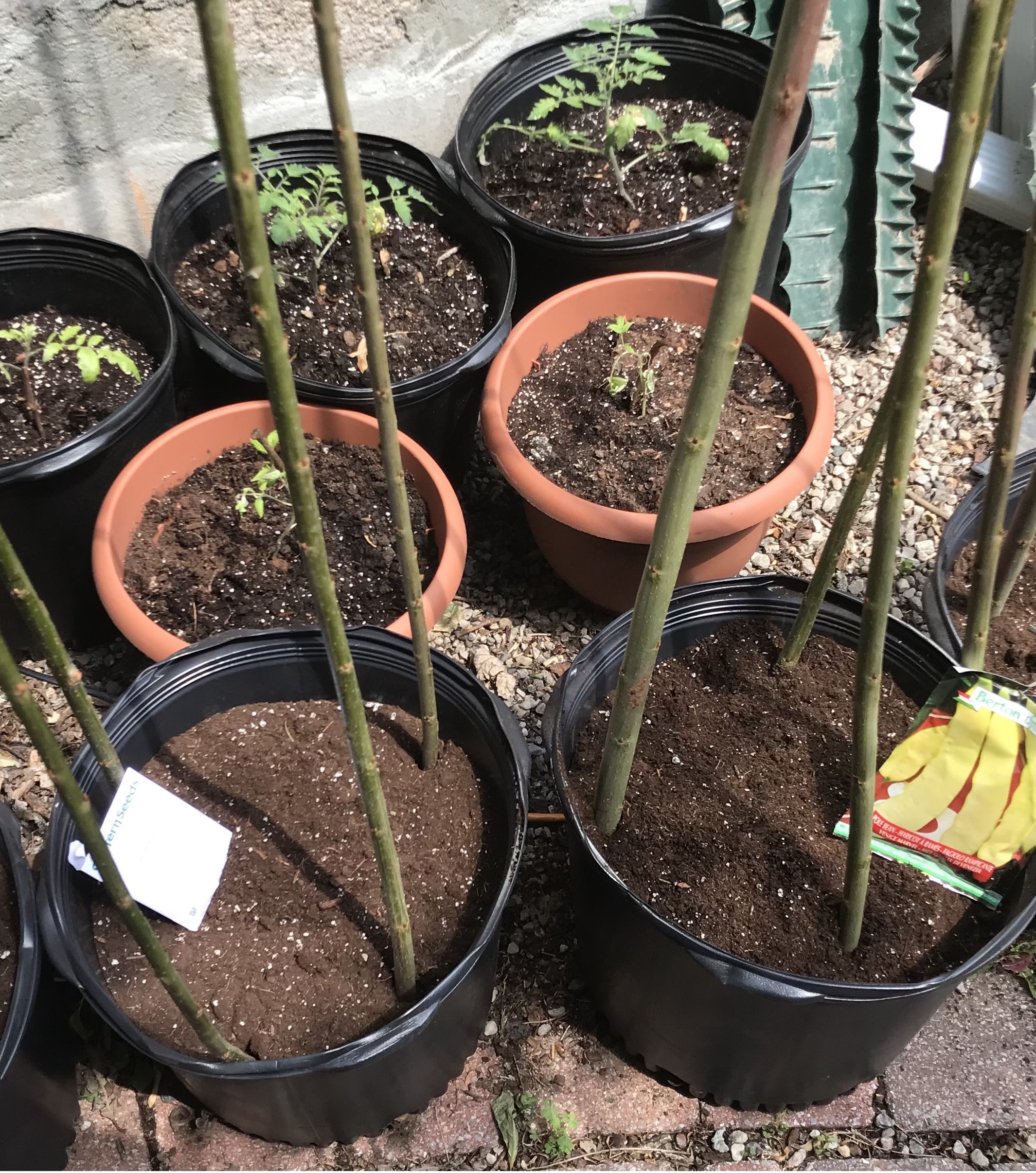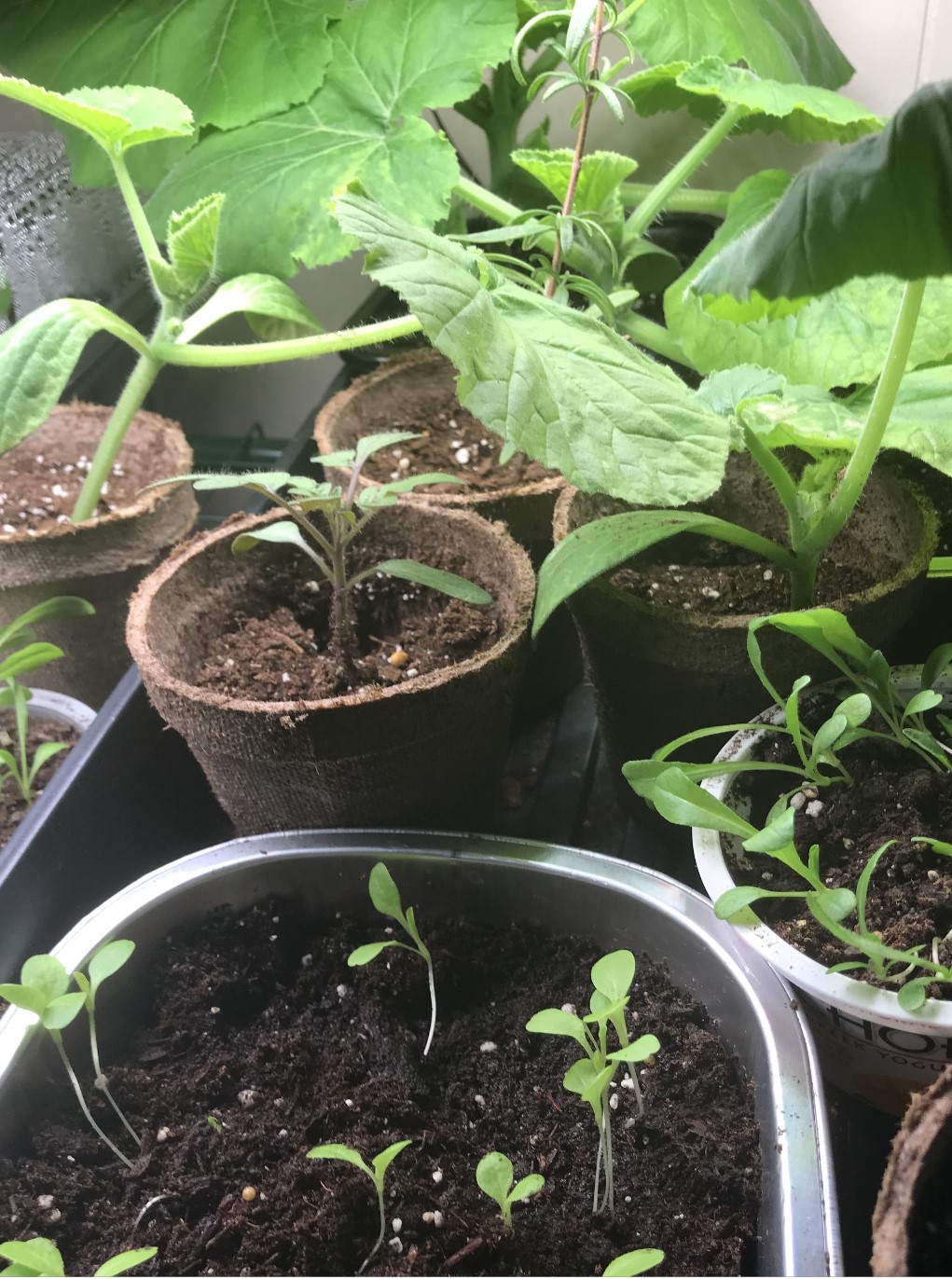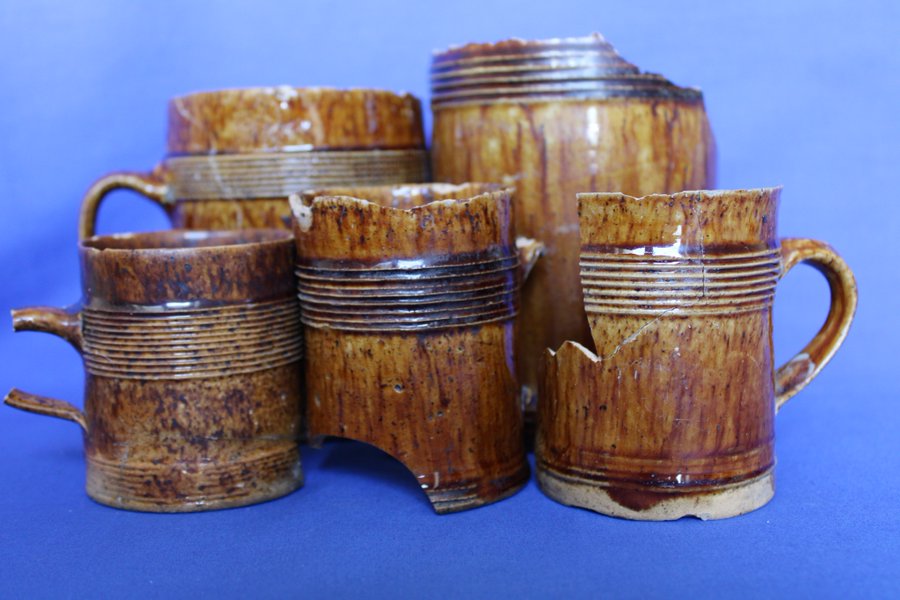 What a week. I spend the week’s few forecasted dry sunny hours on Tuesday evening hands on knees with this newly acquired handy friend indeed clearing out a patch invaded by raspberries and catnip about seven by ten foot to move some of the tomato plants into. I wanted to lay down and weep by the end me being an old guy and all but it’s got to be done. It’s really getting out of hand out there. I have a pot problem. Bought another six to fill Monday night just in case. “Just in case of what exactly?” I later thought. Seventeen zucchini seeds hit the soil on Saturday and pole beans were added on Sunday too, as illustrated. Who is going to eat all this other than the bugs and birds?
What a week. I spend the week’s few forecasted dry sunny hours on Tuesday evening hands on knees with this newly acquired handy friend indeed clearing out a patch invaded by raspberries and catnip about seven by ten foot to move some of the tomato plants into. I wanted to lay down and weep by the end me being an old guy and all but it’s got to be done. It’s really getting out of hand out there. I have a pot problem. Bought another six to fill Monday night just in case. “Just in case of what exactly?” I later thought. Seventeen zucchini seeds hit the soil on Saturday and pole beans were added on Sunday too, as illustrated. Who is going to eat all this other than the bugs and birds?
Where to begin this week? There’s a lot so perhaps at the outset just a summary of the endsy timesy news of the week. The spokesperson for the BA actually used the phrase “craft slowdown” this week. Mirrors perhaps the excellently honest new B+B tag for these times: “the age of divestment“! We learned this week, as Stan noted, “stunning is the news” that Anchor‘s beer will be far less common a sight. We also heard (as I dutifully discussed back in late April) that things are not going so well financially at BrewDog as the Morning Advertiser shared:
BrewDog has reported an operating loss of £24m in its latest trading update… which BrewDog founder James Watt attributes to the cost of investing in the brand, its people and its bars, alongside the “devistating” increase in input costs.
All of which unnervingly indicates that the losses were due to making less money than they spending on, you know, their core activities. All of which leads me to wonder if an ebbing tide lowers all boats. Not yet here in Canada where there was a very sensible bit of consolidation as reported by the clever folk behind the Canadian National Beer News Service, a branch of the Department of The North:
Corby Spirit and Wine Limited has announced that it is set to purchase Ace Beverage Group, parent company of Ace Hill Beer and several other beverage alcohol brands, including Cottage Springs and Cabana Coast ready-to-drink cocktails, Liberty Village cider, and Good Vines wine spritzers. The transaction will see Corby acquiring 90% of Ace’s shares for $148.5 million, with call options on the remaining shares that can be exercised in 2025 and 2028.
That’s real money but apparently the beer assets is one of the least attractive part of the deal. Despite its ongoing move to be about less beer hunting, there was an similar tale told about Ninkasi Brewing in GBH. More good beer settling in as just a part of a portfolio.
Settling. Phil of the excellently named Oh Good Ale in a post also excellently named as “Toil and Trouble“* wrote about a survey retaken after ten years, a repeated of a 2013 census of sorts studying pubs, breweries and cask ale in one part of Manchester England, Chorlton, and had surprising results:
What’s changed? Well, many things have changed – I’m comparing April with June, apart from anything else, so it may possibly be that some of those bars were running dry due to warm-weather demand. Other than that, I was expecting to see little change among the (seven) bars of 2013 – six of them still are bars, after all – and carnage among the (22) breweries, but if anything it was the other way round. As far as I can make out, only three of the 22 breweries have closed outright…
What he found had changed was in the pubs, that the range of service had retracted leading him to state that “the cask bubble in Chorlton and environs has pretty well burst” leading in turn the Tand himself to comment:
…leaving cask to those that handle it well is good policy and the points about addressing a mixture of beer expert and cheapskate are well made.
So perhaps not so much a burst bubble as enthusiasms becoming cammed doon. No, craft is not to blame as it is retracting too. It’s all just a bit of balancing out.
Lisa is not settling. She has scouted out another weird pub for her guide to Dublin starting with this appealing intro:
I must admit, the immediate vicinity of this week’s pub is something I typically speed through as quickly as possibly – the visual clutter from its side of Westmoreland Street is not the most inviting vista, featuring, as it does, the National Wax Museum (NATIONAL WAX MUSEUM), lots of plastic major-brand logos, and CCT Dublin’s building in that block must be one of the worst insults to architecture in any European capital (and I have a soft spot for a lot of ‘ugly’ kinda-Brutalist buildings, but this…is not that).
Beet beer is in the news care of Pellicle (and it’s a favourite of mine given we have year round access to my nearby neighbours’ MacKinnon Bros Red Fox Ale which is made with good Ontario root veg):
Given all these strengths, I asked the brewers why they thought beets weren’t a more common beer addition, especially given the great diversity of fruits and other adjunct ingredients brewers are experimenting with these days. Part of it, of course, is that beets are just a contentious food. Todd, for his part, doesn’t find it terribly surprising that so few brewers have touched beetroot. “I recently saw a meme about fast food variety, and it just showed fried chicken sammies from every chain. That is basically craft beer right now, but sub in hazy IPA/kettle sour. Yes, there is a lot being added to beer these days but I would say that it isn’t really experimental, or very courageous,” Todd says. “For real, no shade over here, but the ingredients people are using could be mistaken for a candy shop or ice cream parlour.”
I like that… because if ye’ve no eaten your veg you cannie hae any puddin!
A fitting obituary for a great rugby player and beer man, Paul Rendall:
He would often proclaim Nunc est bibendum. For those old team-mates who had not studied Latin, he would explain, in the bar, of course, that now it is time to drink.
Drinks Business had a great piece this week unpacking more about that waste water beer building that I mentioned a month ago in San Fran:
In an experiment, Epic fed wastewater from a large San Francisco apartment block through “ultrafiltration membranes” 100 times thinner than a human air. They filter out impurities and the cleaned water is then disinfected by using ultra-violet light. Tartakovsky told CNBC this process is comparable with the biology that takes place in the human stomach. And seemingly it works. He claimed that independent testing of Epic’s cleaned water shows it meets US Federal standards for drinking water and often exceeds them. Cleaned water was passed to Devil’s Canyon Brewing Co in San Carlos California, which produced the Epic OneWater Brew.
What else is out there in the world? Well, The Beer Nut continued his wandering ways and has reported on a trip in May to Haarlem in The Netherlands and found a lack of wallop:
While I’m used to the Dutch people’s effortless fluency in English, I’m not sure that Black It Up! was a great name for the beer. Echoes of Zwarte Piet linger there. I liked the tarry bitterness in the aroma here, presented with a little black pepper spice. It was unfortunately rather more ordinary to taste: dry and roasty with only a token treacle effect to thicken and sweeten it, and no proper hop wallop. I feel that something of this nature should be delivering wallop aplenty; instead this is calm, restrained and frankly a bit boring. Oh well.
Sounds a bit like me. Anyway, speaking of The Netherlands, Ron has been in Vietnam revealing all on the breakfasts to be found near the lobby among other things. And, elsewhere, Stan is reporting from the hop fields again, with his jam packed June 2023 edition of Hop Queries now out. This month we learn that:
Friday the USDA forecast hop acreage strung for harvest in 2023 in the Northwest will be down 8%, or 5,067 acres, from 2023. That’s only about half of the reduction John I. Haas CEO Alex Barth told those attending the American Hop Convention is necessary to begin to get American hop supply and demand back in balance. More likely will be needed… Because general agreement is that the alpha market is in balance, that means the reduction must come from varieties valued first for their aroma and flavor. In fact, farmers added more than 2,500 alpha acres (primarily +1,960 CTZ and +555 Pahto), and aroma acreage was down more than 7,500.
The fabulousness that Stan brings is rooted in the shameless presentation of hop production as agriculture. Fact fact factity fact. You might as well be reading reports from an early US ag societies studying barley growth over 200 years ago. It is all a continuum of knowledge development that sits as a counterpoint to the sorts of approaches to appreciation that startle one with their admitted limitations:
…there’s nothing wrong with mystery, I try to use it when I can for if you stuck to the plain facts with beer you would have writing on a par with that covering the drainage industry or the world of pallets
Speaking of facts, we had a wonderful bit of pushback published this week by a very unhappy investor in the now restructuring Black Sheep Brewery, one of England’s longest serving micros. See, as noted in my May 4th editon of these my scribbles, when everyone cheered Hooray! at the idea it was not shutting so much as getting its affairs in better order we must remember that one of the realities when a firm goes into administration is that the necessary new money may well have to bump away a lot of the old. As we are told is happening in this case:
Long before Covid, when interest rates were at all-time lows and trading conditions were relatively benign, I clearly identified the coming apocalypse, and tried to spell out to those few of you who would listen that “The End was nigh”. Back then, there was still an opportunity to raise new equity, properly invest in our brand, arrange for regulatory accreditation of the packaging plant, smell the coffee, or rather understand where national beer consumption, and indeed alcohol, trends were heading, and to truly “Build a better Black Sheep”. My prescient web-site spelled it all out for you.
The piece goes on to name names and point pointed fingers. I expect the law will be applied appropriately.
Not dissimilarly in terms of a daring do done, I was surprised in a very familiar way by the wild eyed responses to the excellent opinion piece published by Pellicle this week. An editorial. Now, right up front we have to be clear – good beer is no place for forming and certainly no place for sharing opinions or editorials so it is fair that it created a sort of confusion in the hearts of many. Don’t worry. It’s just like that feeling you felt when you saw a small dog in bright yellow rain boots for the first time. Odd but it actually works.
And what was the problem? What upset the universe? Well, if you really want to know, this is the sort of vile sprew that society faced when it woke on Monday morning:
I respect the importance of linking beer back to its agriculture—in fact this is something I feel personally invested in—but this is not the same thing as terroir. Beer is not merely a representation of the land from where its ingredients came, and to advertise it as such underplays the significance inherent to the production of both beer itself, and its individual raw materials.
Good Lord! The gall of the man!! See… see… err… well, that actually all makes fairly perfect sense doesn’t it. Hardly an opinion at all. Most agreed. It’s practically cheery out there. Yet… we are faced with three sorts of minor rebuke (aside from the usual scoffy self-satisfied crab bucketeers in the corner): (i) “Wrong!” (ii) “Clickbait!!” and (iii) you have to appreciate that to be an expert you need to understand that nothing means anything so trying to explain stuff is pointless… as well as combinations of that trio of top notch beer writing principles right there. We are, as always, formed and framed by our weaknesses more than our strengths.
Stan shared a well considerd counterpiece supporting the use of terrior in relation to beer. Read the whole thing but here is the nub:
I became more comfortable with the word as I researched “For the Love of Hops” and continued with “Brewing Local,” although I continue to prefer “taste of place.” Amy Trubek concludes “The Taste of Place: A Cultural Journey Into Terroir,” an absolutely terrific book, by writing “ . . . the taste of place exists, as long as it matters.” To repeat myself, I’m more inclined to use the words taste of place opposed to terroir, but I’m fine with “beer terroir exists, as long as it matters.” Both matter to me.
That works, too. For me? A bit of this has always been the way. There is a simmering desire in beer writing for the shortcutting convenience that making X mean Y brings. The extrapolation slipped in here or there. And there is no X that is more attractive to beer culture as a Y construct than a well grounded principle from the much more established world of wine. So, we have a slightly wonky beer styles construct because wine has naturally developed styles. And we have mildly informative beer atlases mainly because wine legend Hugh Johnson made an excellent one about wine that has been regularly updated.** Just recently Garrett Oliver illustrated this tension (and perhaps even envy) recently when he wrote:
We sometimes forget that the projection of meaning is WORK. Hard work. The wine industry does that work. The beer industry, by and large, does not. This is one reason why wine and spirits are eating our lunch, especially in the US.
And the results and the dear are real. At least here in Canada, where we have moved from a marketplace where (i) in 2002, beer had a market share of 50 per cent by dollar value, while wine had 24 per cent to one (ii) to 2012, to one with a 44 per cent beer to 31 percent wine ratio and (iii) by 2022, we have a 34.9% beer to 31.3% wine. There is cause for concern.
 Hmm. What does it mean and where does it all take us? I like this take by T-Rex to my left, your right. And little while ago, Jeff wrote very sensibly how a technique is not a style. Similarly, things can only bend so far and we need to agree that terroir is not defined by a technique. Technique is not terroir. A yeast strain that’s been transported world wide as terroir? Nope. That’s all square-holery-round peggishness to me. Works for you? Fine… but it’s utterly unnecessary and may undermine things. Don’t get me wrong. I have been into good wine for as long or longer than I have liked good beer. I have even tended to my own vineyards in two provinces, mainly to the delight of birds. For my money, the two trades deserve to return to their largely separate and well-defined lexicons if anything is to be understood in itself. Ditch the code and, as Matt wrote, all that it is covering up. Clarity avoids confusion. Get at that, please. Yes, you. The problem is… I am not sure how much of beer writing is meant to do that, if it is meant to make things clearer to the beer buying public.*** There is comfort in mystery apparently. And, in a world where some of the expertise is based on hanging out one’s own shingle or … where one has little else, well… one has to protect one’s reputation. Doesn’t one.
Hmm. What does it mean and where does it all take us? I like this take by T-Rex to my left, your right. And little while ago, Jeff wrote very sensibly how a technique is not a style. Similarly, things can only bend so far and we need to agree that terroir is not defined by a technique. Technique is not terroir. A yeast strain that’s been transported world wide as terroir? Nope. That’s all square-holery-round peggishness to me. Works for you? Fine… but it’s utterly unnecessary and may undermine things. Don’t get me wrong. I have been into good wine for as long or longer than I have liked good beer. I have even tended to my own vineyards in two provinces, mainly to the delight of birds. For my money, the two trades deserve to return to their largely separate and well-defined lexicons if anything is to be understood in itself. Ditch the code and, as Matt wrote, all that it is covering up. Clarity avoids confusion. Get at that, please. Yes, you. The problem is… I am not sure how much of beer writing is meant to do that, if it is meant to make things clearer to the beer buying public.*** There is comfort in mystery apparently. And, in a world where some of the expertise is based on hanging out one’s own shingle or … where one has little else, well… one has to protect one’s reputation. Doesn’t one.
Finally and just perhaps unrelatedly, I have a hard time getting my head around the idea that the Nigerian non-alcoholic beer market is worth 6.2 billion USD when the same article states:
BusinessDay’s findings showed the firm incurred a loss of N10.72 billion in the first quarter of 2023 from N13.61 billion in the same period of 2022. The firm’s net revenue amounted to N123.31 billion in the first quarter of 2023, a 10.5 percent decline from N137.77 billion in the comparable period. “Despite challenges, the opportunities in the coming decades for non-alcoholic beers are quite as substantial. That is a prospect worth drinking to,” John said.
Worth nothing that the collapsing Nigerian Naira is currently worth 0.0021 USD and, as the same article states, roughly 50 percent of Nigeria’s brewing input costs is imported.
That’s it! That’s enough from me. I need to save my strength for the allotment my house now sits in. Back to you for now as always. And as per, you can check out the many ways to connect including these voices on Mastodon, the newer ones noted in bold:
Stan Hieronymus | The Man!
Boak & Bailey | The B² experience
Curmudgeon Ale Works | Jonathon is Brewing
Katie Mather | Shiny Biscuit and Corto
David Jesudason | “Desi Pubs” (2023) author
BeoirFest | They say “Let’s Talk Beer”
Ron Pattinson | The RonAlongAThon Himself
Al Reece AKA Velky Al | Fuggled
Jennifer Jordan | US hops historian
Alan McLeod | A Good Beer Blog (… me…)
Andreas Krennmair | Vienna beer and lager historian
Beer Ladies Podcast | Lisa Grimm and colleagues
The Bar Towel | Toronto’s chat zone for beer lovers
Chicago Beer Society | Folk in Chicago getting social over beer
Jay Brooks | Brookston Beer Bulletin
Joe Stange | Belgian beer expert, beer magazine editor
Cider Bar | Barry makes Kertelreiter cider
Laura Hadland | CAMRA historian and beer writer
Brian Alberts | US beer historian
Jon Abernathy | The Beer Site
Maureen Ogle | US Beer Historian
Lars Garshol | Norwegian Beer Historian and Kveik Hunter
James Beeson | Beeson on Beer
Carla Jean | MAINER!!!
Thandi Guilherme | Beer Ladies Podcast Co-host
Lisa Grimm | Beer Ladies Podcast Co-host
Roy of Quare Swally | Beery ramblings from Northern Ireland
Rob Talksbeer | Podcaster and Youtuber
Anthony Gladman | UK Drinks Writer
Jeff Alworth | Manna Of Beervana
Northwest Beer Guide | Fairly self explanatory… but not NW Latvia…
Evan Rail | Prague based GBH editor, freelance writer, NYT etc.
Todd Alström | 50% of the Alströms
Jacob Berg | Beer talking librarian
Anyone else? And, yes, we also check the blogs, podcasts and newsletters to stay on top of things – including more weekly recommendations from Boak and Bailey every Saturday and Stan at his spot on those Mondays! Get your emailed issue of Episodes of my Pub Life by David Jesudason on many Fridays. Once a month, Will Hawkes issues his London Beer City newsletter and do sign up for Katie’s now more occassional but always wonderful newsletter, The Gulp, too. Ben’s Beer and Badword is back! And check out the Atlantic Canada Beer Blog‘s weekly roundup. There is new reading at The Glass. Any more? Yes! Check to see the highly recommended Beer Ladies Podcast. And the long standing Beervana podcast . There is the Boys Are From Märzen podcast too and check out the travel vids at Ontario’s own A Quick Beer. There is more from DaftAboutCraft‘s podcast, too. All About Beer has introduced a podcast. There’s also The Perfect Pour. Plus follow the venerable Full Pint podcast. And the Craft Beer Channel on Youtube soon celebrating a decade of vids. And remember BeerEdge, too, and The Moon Under Water… if you have $10 a month for this sort of thing… I don’t. Pete Brown’s costs a fifth of that. There was also the Beer O’clock Show but that was gone after a ten year run but returned renewed and here is the link!****
*Here you go. Here’s the reference.
**When the fam says “What? Why?” when I pull out a bottle of something tasty, I pull out my atlas, point at a patch of a few hundred square metres and say “From that field right there!“
***See, if you see nuance or complex or subtle being used to point at things that are merely specific or one part of a long list, just as with “mystery” as cited above, you might be in the doldrums of such conditions. Hanging out with engineers taught me this. Engineers are the heroes of the lengthy sensible to do list. Put things on it when you think of them and strike them off when they get done. Build a few bridges and you learn this sort of thing.
****And finally the list of the departed newsletters and podcasts or those in purgatory. Looks like both Brewsround and Cabin Fever died in 2020, . We appreciate that the OCBG Podcast is on a very quiet schedule these days – but it’s been there now and again. The Fizz died in 2019. Plus Fermentation Radio with Emma Inch seems done and the AfroBeerChick podcast is gone as well! The Fingers Podcast packed it in citing, umm, lack of success… as might have been anticipated, honestly. Did they suffer a common fate? Who knows?







 First up, I had no idea that there had been the perfect TV show for the dedicated indoorsman until the Mudge shared a clip from “
First up, I had no idea that there had been the perfect TV show for the dedicated indoorsman until the Mudge shared a clip from “



 The autumn leaves are a ways off falling but the time is coming fast. We have had nothing but great grass growing weather in these parts so more with the mowing than action with the rake so far. And as we say goodbye to saying goodbye
The autumn leaves are a ways off falling but the time is coming fast. We have had nothing but great grass growing weather in these parts so more with the mowing than action with the rake so far. And as we say goodbye to saying goodbye
